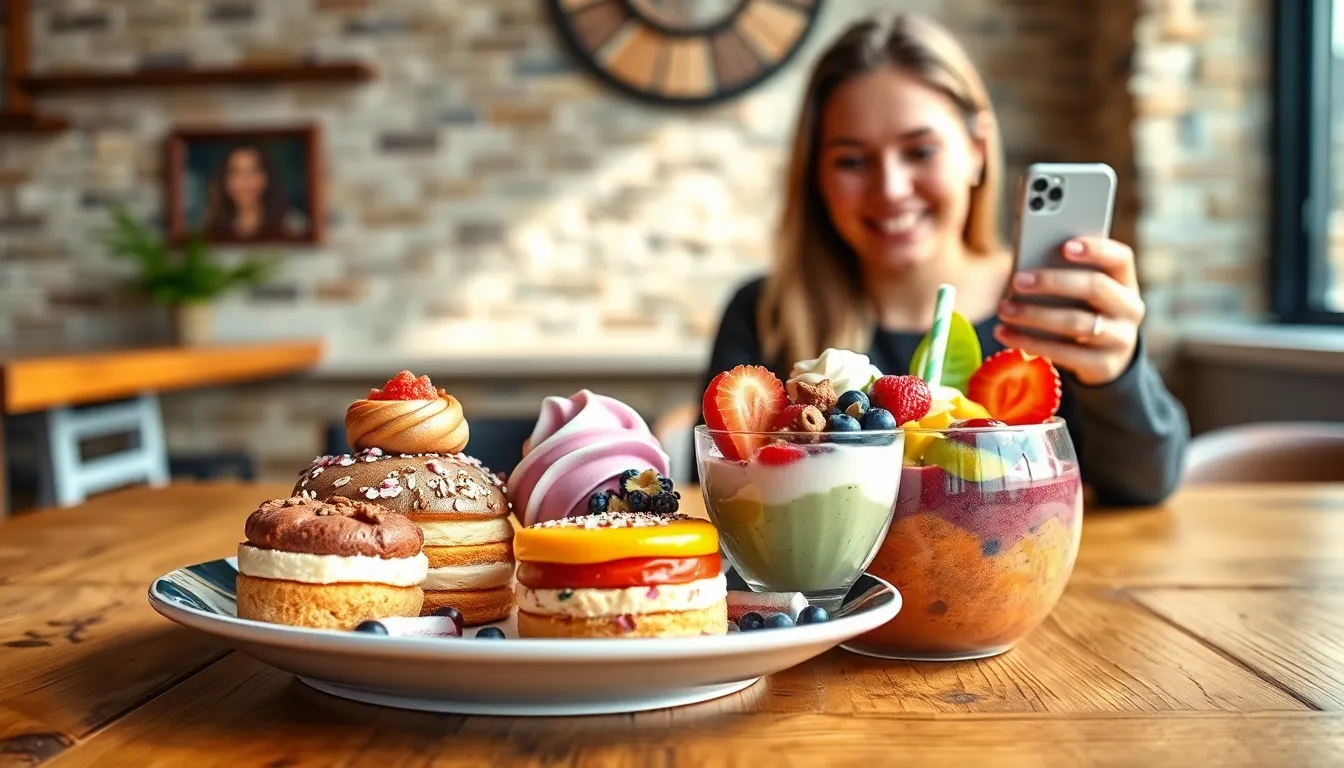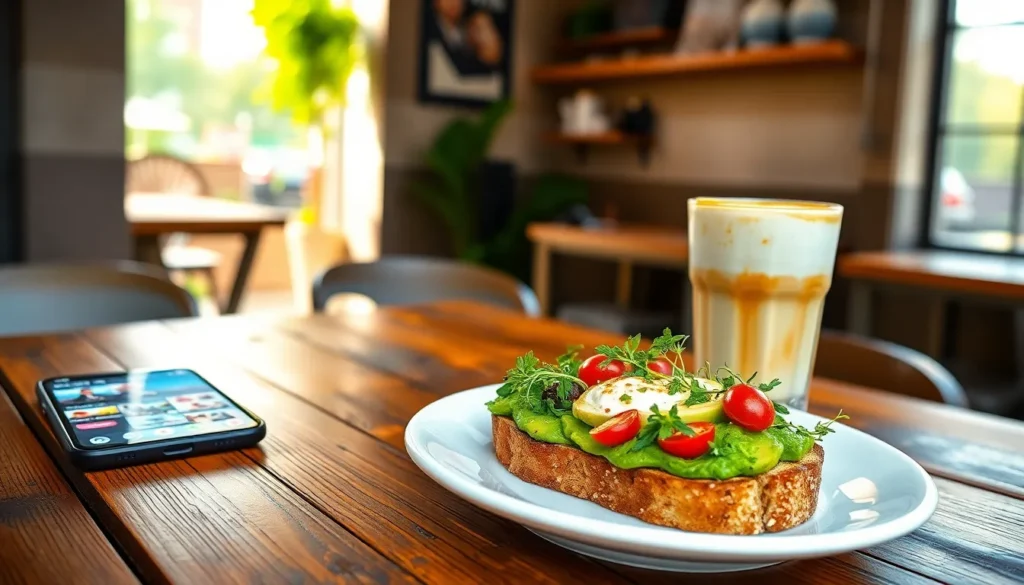Table of Contents
ToggleIn a world where avocado toast reigns supreme and unicorn lattes spark joy, social media food trends have transformed the way people eat, cook, and share their culinary adventures. With every scroll, there’s a new dish begging for attention, from rainbow bagels to cloud bread. It’s not just about taste anymore; it’s about the ‘grammability’ of every bite.
Overview of Social Media Food Trends
Social media platforms reshape food trends by emphasizing visually appealing dishes. Culinary experiences have shifted, as users often prioritize the aesthetic over traditional taste. Instagram finds itself at the forefront, with hashtags driving the popularity of vibrant meals. Visually striking items, like matcha pancakes and rainbow bagels, gain traction quickly among users.
Food influencers significantly impact what trends emerge. Individuals with large followings can create buzz surrounding new flavors and dishes. Their recommendations lead to viral sensations, inspiring others to recreate stylish recipes at home. These influencers play a crucial role in popularizing not just food items but entire cuisines.
Engagement metrics reveal significant trends in consumer behavior. According to research, 76% of consumers report being influenced to try new foods based on social media posts. Users share their culinary creations, leading to an increase in unique and creative dish presentations. FOMO (fear of missing out) drives individuals to taste the latest food fads, often contributing to rapid turnover in popular dishes.
Conversely, social media fosters community among food lovers. People connect through shared interests, exchanging recipes and tips. Communities often ignite movements around specific ingredients, such as the rise of plant-based diets fueled by platforms like TikTok. Vegan recipes consistently gain attention, showcasing a growing trend toward sustainability.
Lastly, brands also adapt to social media trends. Food companies leverage user-generated content in marketing strategies, tapping into authentic engagement. By aligning marketing efforts with trending dishes, they maintain relevance in a rapidly evolving culinary landscape.
Popular Social Media Platforms Influencing Food Trends

Social media platforms drive food trends, with users sharing visually stunning dishes that capture attention. These platforms allow culinary creativity to flourish, influencing what people eat and cook.
Instagram’s Impact on Food Aesthetics
Instagram shapes food aesthetics significantly, encouraging visually appealing presentations. Users often prioritize how their meals look, promoting dishes like colorful smoothie bowls and artful desserts. Hashtags streamline discovery, enabling users to explore vibrant creations. Engaging imagery attracts attention, influencing followers’ choices. Research indicates that 76% of consumers are inspired to try new foods based on posts. The platform’s emphasis on ‘grammability’ drives restaurants to design meals specifically for photos. The pursuit of likes encourages innovative approaches in plating and food styling.
TikTok’s Viral Recipes
TikTok revolutionizes how recipes spread, transforming cooking into a dynamic experience. Short videos provide accessible tutorials, igniting food trends like cloud bread and whipped coffee. Creative editing captivates viewers, encouraging experimentation with unique ingredients. The immediacy of trend cycles keeps audiences engaged, prompting rapid recipe sharing. Analytics reveal TikTok significantly influences food choices, with users eager to recreate popular dishes. Additionally, the platform’s algorithm helps new flavors gain traction quickly. Viral challenges unite users, fostering a collective culinary journey that reshapes dining habits.
Emerging Food Trends in 2023
2023 showcases exciting food trends influenced by social media. The focus on visual appeal and sustainability continues to grow, shaping culinary experiences.
Plant-Based Innovations
Plant-based food is at the forefront of culinary innovation. New alternatives like mushroom-based meats and pea protein products gain popularity among health-conscious consumers. Surveys indicate that 60% of consumers actively seek plant-based options. Trending dishes, such as vegan sushi and meatless tacos, attract attention for their flavor and creativity. Social media amplifies these offerings, influencing individuals to adopt more plant-based meals in their diets. Marketers also address this shift, developing campaigns that spotlight plant-based innovations to engage their audiences.
Global Cuisine Fusions
Fusing global cuisines creates unique culinary experiences. Culinary enthusiasts experiment with hybrid dishes like Korean tacos and sushi burritos. These creative blends reflect the growing appreciation for diverse flavors, appealing to adventurous eaters. Approximately 70% of diners express excitement about trying foods from different cultures. Social media boosts exposure for these fusion dishes, contributing to their rapid rise in popularity. Chefs and home cooks alike share innovative recipes, inspiring community members to embrace cross-cultural culinary explorations.
The Role of Influencers in Food Trends
Influencers play a crucial role in shaping food trends on social media. Their ability to connect with large audiences fosters excitement around new culinary experiences and styles.
Building a Food Brand on Social Media
Establishing a food brand on social media requires authenticity and appealing visuals. Engaging content attracts followers and keeps them invested in the brand. Posts featuring vibrant colors and innovative dishes often receive high engagement, making the aesthetic presentation essential. Brands incorporate storytelling to create a personal connection with followers. Meal prep videos or behind-the-scenes glimpses of kitchen processes resonate with audiences. Data shows that 76% of consumers try new foods based on influencer recommendations. Incorporating user-generated content further enhances authenticity, driving community interaction and inspiring loyalty among customers.
Case Studies of Successful Food Influencers
Numerous food influencers have successfully changed the culinary landscape via social media. For instance, the viral appeal of accounts like @chefsouschef showcases innovative recipes that followers recreate at home. This account highlights popular trends such as whipped coffee and cloud bread. Another example is @veganfoodspace, which promotes plant-based diets and shares visually stunning meals, contributing to a 60% increase in interest among health-conscious consumers. Engagement on these platforms often amplifies trending dishes, with the fusion of global cuisines capturing attention. Enhanced visibility of unique offerings like Korean tacos motivates adventurous eaters to explore new flavors.
Consumer Behavior and Social Media Food Trends
Social media significantly influences consumer behavior in the food industry. Platforms like Instagram and TikTok shape preferences through visually enticing content and interactive engagement.
Engagement and Interaction with Food Content
Users actively engage with food-related posts, leading to trends gaining momentum. 76% of consumers feel inspired to try new foods based on social media content. Sharing culinary experiences encourages community interaction, fostering an environment where food enthusiasts exchange recipes and ideas. Well-crafted posts that attract likes and comments create a sense of connection among followers. Food brands capitalize on this engagement through authentic user-generated content, leading to greater brand loyalty and visibility.
The Shift Towards Healthier Choices
Health-conscious consumers increasingly prioritize nutritious options. The demand for plant-based foods has surged, with 60% actively seeking alternatives to animal products. Social media amplifies this shift by showcasing innovative dishes like vegan sushi and meatless tacos. As followers explore healthy recipes, they encounter diverse culinary experiences and worldwide flavors. This trend fosters excitement about nutrition-packed meals, leading to a more informed customer base eager to adapt their diets.
Social media continues to transform the culinary landscape by influencing food trends in unprecedented ways. The emphasis on visual appeal and shareable content has made meals more than just sustenance; they’re now experiences to be captured and shared. As food enthusiasts connect through platforms like Instagram and TikTok, the excitement around innovative dishes and diverse cuisines only grows.
The rise of plant-based options and fusion foods highlights a shift toward healthier and more adventurous eating. Influencers play a pivotal role in this dynamic environment, inspiring followers to explore new flavors and cooking techniques. As social media evolves, so will the trends it shapes, ensuring that the culinary world remains vibrant and ever-changing.







